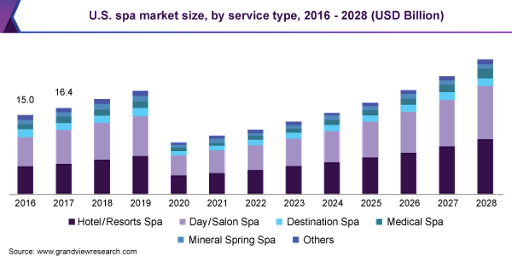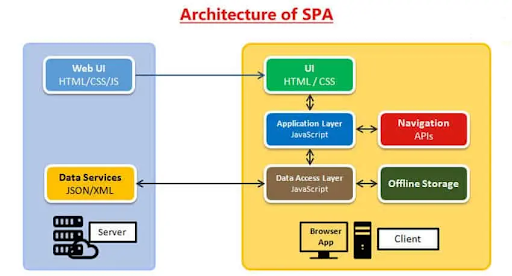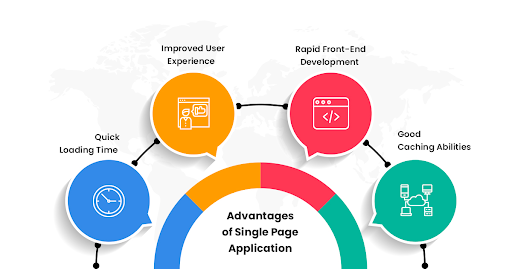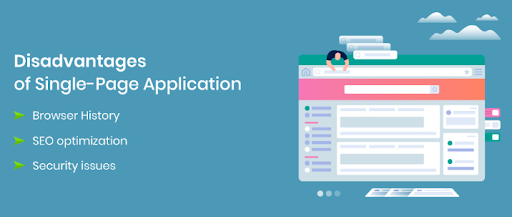A Single Page Application (SPA) is a web application that loads all its content on a single page. This contrasts with traditional web applications, requiring users to load a new page every time they want to view additional content.
SPAs are popular amongst enterprises because they offer a better user experience by providing a more seamless and fluid browsing experience.
Also, according to a recent report, the Single page application market is set to grow by $117.9 billion by 2028 at a CAGR of 12.1% from 2021 to 2028.

However, there are also some single-page application disadvantages that you should be aware of before deciding if this type of application is right for your business.
So, in this article today, we will discuss the pros and cons of Single Page Applications and give you some examples of how they are being used today.
Let’s get started!
What is a Single Page Application?
A single-page application (SPA) is typically a web app that loads a single HTML page and then dynamically updates that page as the user interacts with the app. SPAs use AJAX and HTML5 to create fluid and responsive web apps without reloading the page.
Moreover, this approach avoids interruption of the user experience between successive pages, making the application behave more like a desktop application.
Single Page Application Architecture

Source: Gear Heart
To understand Single Page Applications architecture, it’s important to first understand how traditional web applications work. A traditional web application consists of a server that serves up HTML pages to clients, usually responding to a request from the user.
So, when you navigate to a website, your browser sends a request to the server for the page you want to view, and the server responds by sending back the HTML for that page.
With a Single Page Application (SPA), things are different. Rather than having the server send back an HTML page every time the user navigates to a new page, the entire application is initially loaded onto the client-side and rendered in the browser.
Subsequent navigation within the app happens without new pages being loaded from the server; instead, the SPA uses JavaScript to update the current page dynamically.
How Does SPA Work?
SPAs work by loading a web page once and performing all subsequent JavaScript interactions. This means that the web page doesn’t need to be reloaded each time the user wants to view new content or make a change.
Instead, the front-end web framework (such as Angular, React, Vue, or Spring) makes an XMLHttpRequest (XHR) to the server whenever it requires retrieving data.
Any data that’s retrieved from the server is used to update the SPA without reloading the entire page.
This makes SPAs much faster and more responsive than traditional web pages, which need to reload the entire page each time the user interacts with them.
Single Page Application Pros

There are several key advantages of using single-page applications (SPAs) that make them appealing for many web development projects.
- Quick Loading Time
One of the key advantages of a single-page application is that it offers quick loading times. With a traditional web application, each user interaction requires a full page refresh, taking some time.
In contrast, single page applications loads only once, and subsequent interactions happen because they are done on the same page. This can provide a smoother and more efficient user experience.
Additionally, single-page applications can be designed to work offline, a valuable feature for users who need to access information in areas with poor or no internet connection.
- Better User Experience
Single-page applications can provide a better user experience than traditional web applications. Because a single-page application can load all of the necessary HTML, CSS, and JavaScript files upfront, users can interact with the application more quickly and smoothly.
In addition, Single Page Applications can dynamically update content without reloading the entire page, which further improves the user experience.
As a result, Single Page Applications have become increasingly popular as developers strive to create more responsive and user-friendly web applications. You can also avail of application development services by contacting an app development company.
- Reduced Development Costs
The other key advantage is reduced development costs. Single-page applications can be less expensive to develop than traditional web applications. This is because there is typically less code required to build a single-page application.
This can lead to reduced development time and lower overall costs. In addition, single-page applications can be easier to maintain and update than traditional web applications.
There is typically only one page of code to update, rather than multiple pages.
As a result, single-page applications can provide several benefits for businesses.
- Ease in Building Feature-rich Apps
Another advantage of using a single-page application is that it can be easier to build feature-rich applications. This is because all the code and logic for the app live on a single page. The benefits of this approach include easier management and updates for your application and a reduction in network traffic.
In addition to that, because all of the data is loaded up front, there is no need to make additional roundtrips to the server to retrieve data, which can also help improve performance.
- Uses Less Bandwidth
The other significant advantage of a single-page application is that it uses less bandwidth. This means that the application can load faster, even on slow internet connections. Furthermore, it consumes less data, which can be especially beneficial for users with data caps or limited data plans.
Single-page applications also tend to be more responsive since they only need to reload the data that has changed rather than reloading the entire page. This can improve the user experience, as well as reduce server costs. You can also opt for a custom app development option to get your app developed.
Single Page Application Cons

Source: Monocubed
There are a few cons associated with single-page applications (SPAs), and they are the following.
- Doesn’t Perform Well With SEO
The primary issue with SPAs is that they don’t perform well with SEO. Since the content is rendered on the client-side, search engines have difficulty indexing it. This can be a problem for companies that rely on organic traffic to drive business.
In addition, SPAs can be challenging to share on social media due to the way they are structured. Users often have to click through numerous pages before finding the content they’re looking for, which can be frustrating.
As a result, SPAs are not always the best option for companies that need to generate traffic from search engines and social media.
- Uses a Lot of Browser Resources
SPAs can also be resource-intensive, loading a lot of resources upfront and then keeping them in the browser’s memory. Having complex pages with various interactions and animations can quickly lead to memory issues and slow performance.
In addition, because SPAs need to load all of their resources upfront, they usually take longer to load than traditional multi-page applications. This can be a significant issue for users with slow internet connections or limited data plans.
- Security Issues
Because SPAs are typically built with JavaScript, they can be vulnerable to security threats such as cross-site scripting (XSS) and cross-site request forgery (CSRF). These attacks can allow malicious actors to access sensitive data or inject malicious code into the application.
Concluding Thoughts
As we have discussed above, Single page applications are becoming increasingly popular because they offer a more user-friendly experience than traditional web applications.
However, there are some drawbacks to using SPAs that should be considered before deciding to use one for your next project.
The main advantages are that they are easier to build, use less bandwidth, and are more responsive. And the main disadvantages are that they don’t perform well with SEO and can be resource-intensive.
So. I recommend you weigh these factors carefully before deciding whether or not to build a single-page application. You can also contact a premier-class custom app development company to successfully build your application.






 The Best Proxy Server for Puppeteer Automation
The Best Proxy Server for Puppeteer Automation